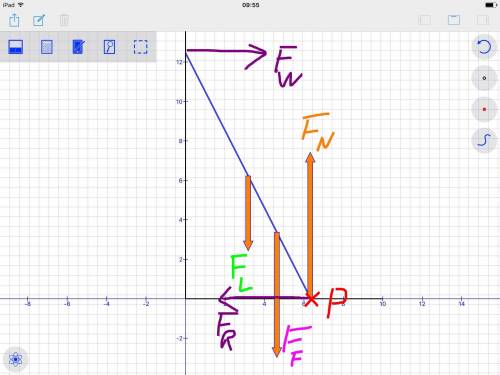
Physics, 07.08.2019 05:20 sadiemk821
A14.0 m uniform ladder weighing 490 n rests against a frictionless wall. the ladder makes a 63.0°-angle with the horizontal.
(a) find the horizontal and vertical forces (in n) the ground exerts on the base of the ladder when an 820-n firefighter has climbed 3.80 m along the ladder from the bottom. (horizontal force, vertical force)
(b) if the ladder is just on the verge of slipping when the firefighter is 9.10 m from the bottom, what is the coefficient of static friction between ladder and ground?
(c) what if? if oil is spilled on the ground, causing the coefficient of static friction to drop to half the value found in part (b), what is the maximum distance (in m) the firefighter can climb along the ladder from the bottom before the ladder slips?

Answers: 2


Another question on Physics

Physics, 22.06.2019 17:40
You throw a baseball directly upward at time =0 at an initial speed of 14.9 m/s. what is the maximum height the ball reaches above where it leaves your hand? ignore air resistance and take =9.80 m/s2.
Answers: 1

Physics, 22.06.2019 23:30
Aball of mass 0.3kg is released from rest at a height of 8m.how fast is it going when it hits the ground? accleration due to gravity is g=9.8m/s
Answers: 2

Physics, 22.06.2019 23:50
An alpha particle with kinetic energy 12.5 mev makes a collision with lead nucleus, but it is not "aimed" at the center of the lead nucleus, and has an initial nonzero angular momentum (with respect to the stationary lead nucleus) of magnitude l = p0 b, where p0 is the magnitude of the initial momentum of the alpha particle and b=1.40×10−12 m. (assume that the lead nucleus remains stationary and that it may be treated as a point charge. the atomic number of lead is 82. the alpha particle is a helium nucleus, with atomic number 2.) what is the distance of closest approach?
Answers: 2

Physics, 23.06.2019 01:00
The amount of heat required to change liquid water to vapor at its boiling temperature is 2256 kj/kg. the amount of heat required to change liquid mercury to its vapor state at its boiling temperature is 295 kj/kg. one kg of each substance is currently at its boiling point. how will the amount of thermal energy required to change each substance from a liquid to a gas differ?
Answers: 3
You know the right answer?
A14.0 m uniform ladder weighing 490 n rests against a frictionless wall. the ladder makes a 63.0°-an...
Questions

World Languages, 27.08.2019 15:20


History, 27.08.2019 15:20









Mathematics, 27.08.2019 15:20


Biology, 27.08.2019 15:20

Mathematics, 27.08.2019 15:20

Social Studies, 27.08.2019 15:20






 = 14 m
= 14 m = 490 N
= 490 N = 3.8 m
= 3.8 m = 820 N
= 820 N
 , force of friction on base of ladder be
, force of friction on base of ladder be  and normal force on base of ladder be N.
and normal force on base of ladder be N.



























